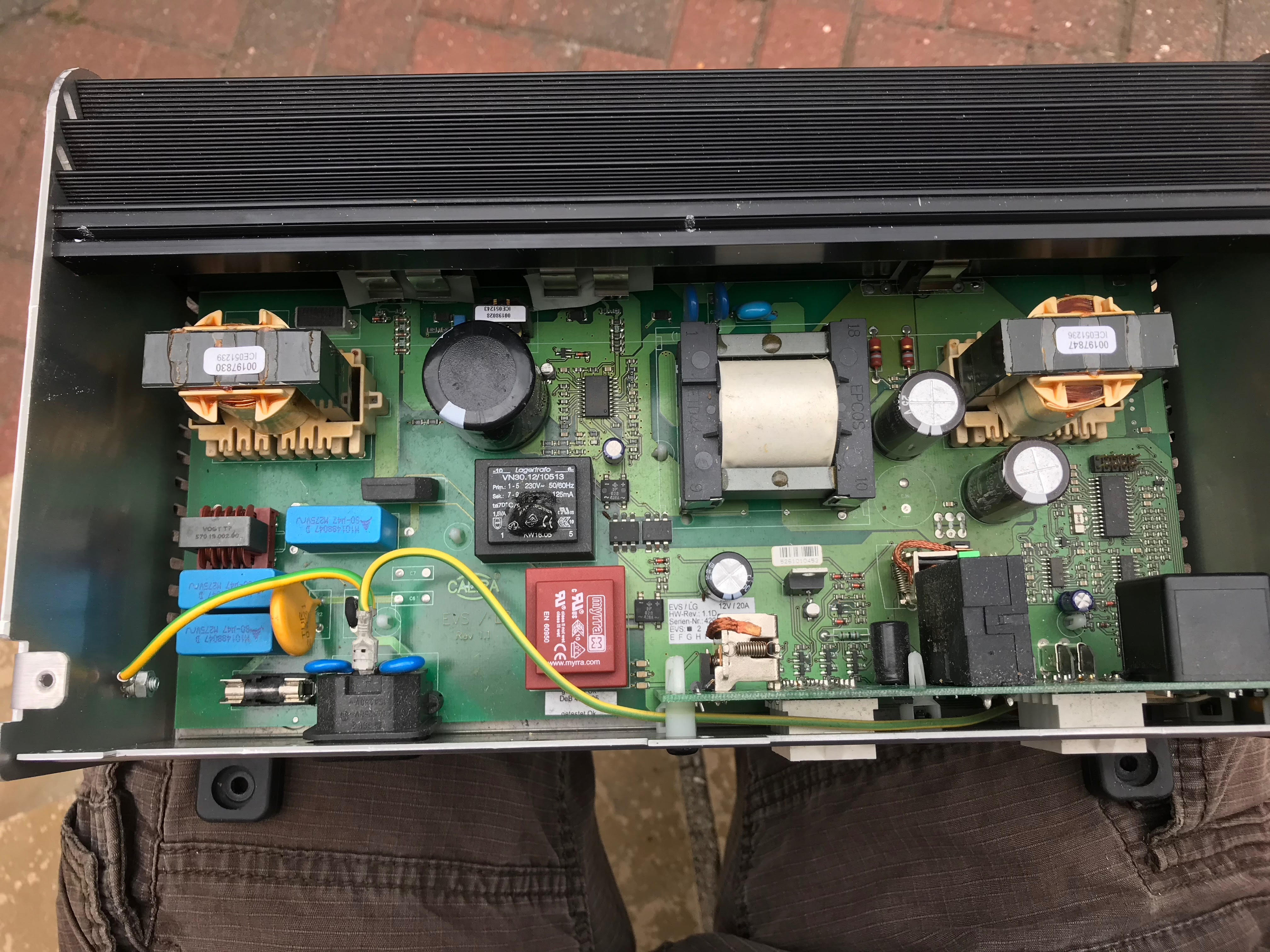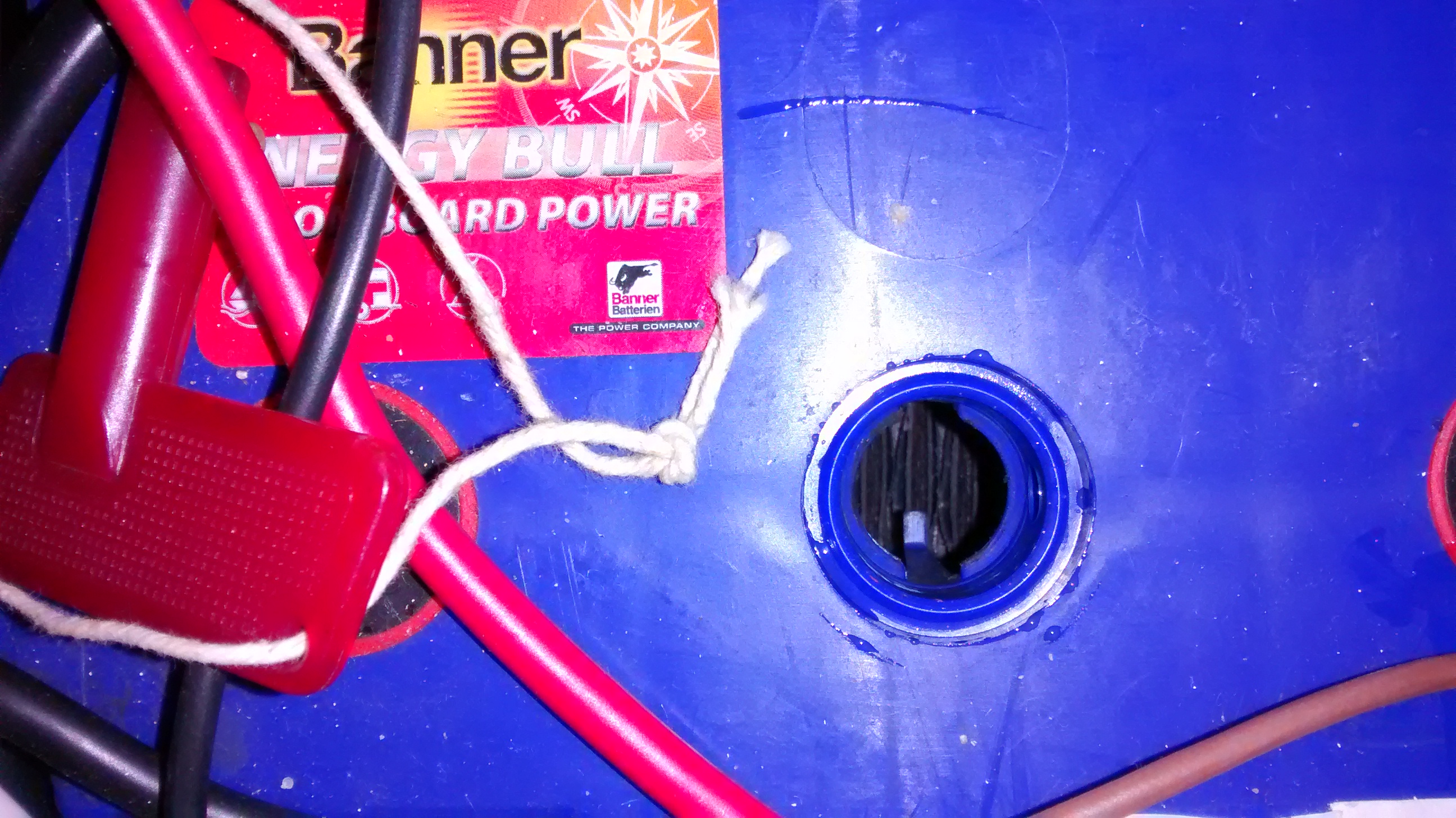Updated 2/05/2019
Is Long Term connection to Electric Mains Hook-Up/Solar Good or Bad?
"My leisure battery exploded last week. The camper was on EHU at the time. Is it possible for me to send you the Calira for diagnostics and repairs? I am based in Oxford.
Regards Sarah."
Sarah's Calira charger was acid damaged beyond repair.
When batteries explode, rectification work replacing fabrics and materials damaged by the flying acid can run into thousands.
See this photo below of another exploded battery :-
We have been writing for a while that long term unattended charging of Motorhome Habitation batteries is not ideal for either the charger or the battery.
As we see it there are 3 issues :
1. Damage to the motorhome if the Battery or charger fault and the battery gives off excessive Acid Gas, explodes or even catches fire. If the charging isn't being monitored closely, then the damage can get out of hand.
2. The continuous charging of a battery that is fully charged but Idle.
3. Damage to the Chargers, as some are not designed for long term connection.
Sarah's exploding battery tale above indicates that charging any battery long term unattended can have expensive consequences as the Acid damage can be significant.
The CTEK XS 7.0 manual states -
"Don’t leave any battery during charging unattended for a longer period of time".
The manual goes on to warn about battery explosion, etc. See the CTEK manual at the bottom of this page : http://www.aandncaravanservices.co.uk/how-does-a-charger-work.php
All the big battery manufacturers state that any idle battery on long term Float, Maintenance, Trickle charge or whatever you know it as, should be maintained around 13,2v not the 13.8v charge rate of many Motorhome chargers.
Float Charging permanently at 13.8v causes battery corrosion, Antimony poisoning and shortened life. Obviously, if the battery is being used to power an Alarm, Tracker, after market Radio memory settings, etc then it will need continuous charging. This advice only applies to batteries that have no drain on them.
As a result they suggest that batteries treated this way should be regarded as having a maximum two year life. See this extract :
"Battery Maintenance in Non-Automotive Float Applications
1.Typical applications are motor-generators, stand-by applications etc. The Leisure Battery range is recommended for these applications; standard vehicle batteries are not suitable.
2. Batteries used in these applications should be changed every 2 years or more frequently. (Continuous charging, even from a well-controlled charging system, will result in internal degradation of the battery. This could result in the battery not giving its predicted output when required even though the battery appears to be fully-charged)".
For the full text, read the bottom of this page : http://www.yuasa.co.uk/info/technical/need-know-batteries/
The Roadpro website as of November 2016 was warning of high fluid loss when used :
"'...... with a solar panel, a battery to battery charger or a mains charger that's on for days at a time, the electrolyte levels of Energy Bull batteries must be checked on a regular basis".
Please employ the AGM setting, which means that the charge voltage should be set at max. 14.8V and the float charge voltage at 13.5V. Best of all, use an IUoU characteristic with temperature compensation (should you have this setting available).
In order to obtain the maximum service life from your battery, please ensure complete separation from the on-board supply (charger) when the vehicle is not in use >7 days.
We think that some people believe that their Motorhome battery charger (either Mains or Solar) shuts down totally when the battery is full. Yet many of the chargers we repair continue to 'force feed' the battery, albeit at a low rate, even when the battery is at maximum capacity.
For example one Solar Regulator we encountered recently 'wakes up' each day when the Sun rises and then goes straight into a 'fast charge' 14.7v for a fixed time of 2 hours, even if the wet acid battery is already fully charged.
It will only drop to a 13.8v 'trickle' charge once the 2 hour timer expires. That will happen 365 days a year. And yes the quote of 14.7v for a wet acid battery is as per it's spec, not the usual 14.4v, so this again will have an 'overcharge' impact.
That will seriously shorten any batteries life if the Solar isn't managed by shutting it off manually.
Full details of the Solar Regulator here :

|
Photonic Universe Solar 20a PTRTracerA user manual.pdf Size : 2244.907 Kb Type : pdf |
The behaviour of this really poor, Solar Regulator above is not unique. We don't know of a single Solar Regulator that 'wakes up' each morning and automatically goes into the battery charging state it was at the night before when the Sun set and the Regulator ceased charging.
For example most Motorhomes will spend at least 50% of the year unused, where the batteries will be unused and fully charged. In these circumstances most Solar regulators will end the day in a 'trickle' charge mode, yet when they power back up the following morning when the Sun comes up, almost all we have seen go into a 'fast charge' mode for a fixed time period, sometimes as much as 4 hours, even if the battery is already fully charged.
The worst offenders are the Solar Regulators designed for 'House Roof' Solar' solutions as they often assume, correctly for a House system, that the owner wants 100% to be thrown at the National Grid. Therefore their design is optimised to start-up and work flat out.
On a European Motorhome specific Solar Regulator, they are designed on the premise that the battery will be fully charged much of the time.
Additionally they 'trickle' charge at a much lower 13.4v. See our Solar Power pages for the Solar Regulators we recommend.
Similarly most motorhome mains 230v chargers do not 'turn off' as many believe, but drop into a low charge mode, still constantly drawing 230v mains electricity and putting around 13.8v into the battery. 13.8v is fine to 'trickle' charge for a few weeks, but not months.
We also see signs inside the battery chargers we repair, that shows they are either not designed to run 365 days a year or suffer if they do.
A great example is the Calira 30/20 where the circuit design was based on a continental 220v supply, not the UK's 240v.
Short term connection to 240v is ok for weeks at a time, but prolonged 240v power, especially at the upper end of 240v, results in over heating and melting of the transformer.
See bubbled Black square in the photo below

The same can happen to the Nordelettronica NE143 that was fitted in many Swift Group Caravans between around 2005 and 2013 and the Reich e-Box.
All of these chargers are reliable well built units when used as designed. But, through the use of poor batteries and/or long term EHU they are damaged before their time.
Solar Chargers.
Schaudt's latest LRM1218 Solar Charger has dropped the Maintenance charge down from the previous units 14.2v maintenance charge to just 13.4v.
Votronic's own new range of MPP Solar chargers also now Maintenance/Float/Trickle charge at 13.4v, suggesting as per other documents now surfacing, that long term EHU at the usual Motorhome/Caravan Chargers 13.8v will have consequences.
Even Victron's base model mains chargers have a specialist Storage mode with an 'ultra low' Float/Maintenance/trickle charge of only 13.2v.
As Victron are just about the only Battery and Charger specialist manufacturer they must think it has value?
The Batteries most degraded by constant EHU charging are the ones that use the very technology often adopted for very Deep Discharge batteries in Motorhomes : Lead Antimony batteries.
A paper by battery expert Steve Clark, see bottom of page for full report, states :
"Today, Antimony alloys dominate the market for cycling applications and due to ease of production are common in developing nations. The dominance of Antimony alloys in the cycling market is based on the fact that the alloy is extremely resistant to distortion or damage from repeated discharge and recharge cycles".
However, he goes on to say that they should never be 'constant charged' :
"Lead-Antimony alloys are not well suited for stand-by service with a constant charge. The phenomenon of antimony-poisoning where antimony from the grid alloy forms small discharge points on the negative plate surface is a direct result of continuous charging. This results in a continuously increasing float current and water consumption over the life of the battery. The rate of antimony-poisoning is directly related to the operating temperature, charging voltage and the antimony content of the alloy".
This Antimony Poisoning is in addition to the accelerated corrosion they will most likely endure.
We think that the likes of Trojan, Rolls and other specialist manufacturers of ultra Deep Discharge batteries are probably the ones most affected by Antimony poisoning from long term charging?
We therefore suggest that you research very carefully the technology inside any Battery you intend to match with Solar or keep on long term EHU.
Clearly, Lead Antimony based Deep Cycle batteries will degrade very quickly if subjected to charging they were never intended to endure. Their life will be shortened and Water loss may be high.
The Banner Energy Bull is an Antimony based battery, here is a very dry one we found earlier :

The above documents the impact on batteries of modern chargers, yet old technology, low power output chargers may not be so damaging. Some Motorhomes, especially British made prior to 2008, tended to have low power chargers, like a fixed 13.5v low current charger. Some new Sargent ECxxx units, like the EC155, EC160, etc still incorporate very low power, lower voltage charges. These will obviously have a far less drastic effect on a battery left on permanent charge than a modern, more powerful multi stage charger. Therefore the above comments won't necessarily apply in full to all Motorhomes/Caravans.
The overall damage to the batteries will depend on the duration, the charger, the battery make, ambient temperature, battery condition, the equipment installed in the Motorhome and the battery technology.
Temperature is a key factor, a Battery continuously Float charged in Iceland may not suffer damage but a battery Float charged during a hot Spanish Summer for just a few Months may suffer significantly.
I would venture to suggest that a battery continuously Float charged by a Solar Regulator in Southern Spain might deteriorate more than a battery in Stornaway kept on EHU through the Winter?
No two Motorhomes will behave the same even if they seem similar.

|
Lead Antimony Acid batteries Steve Clark.pdf Size : 164.528 Kb Type : pdf |